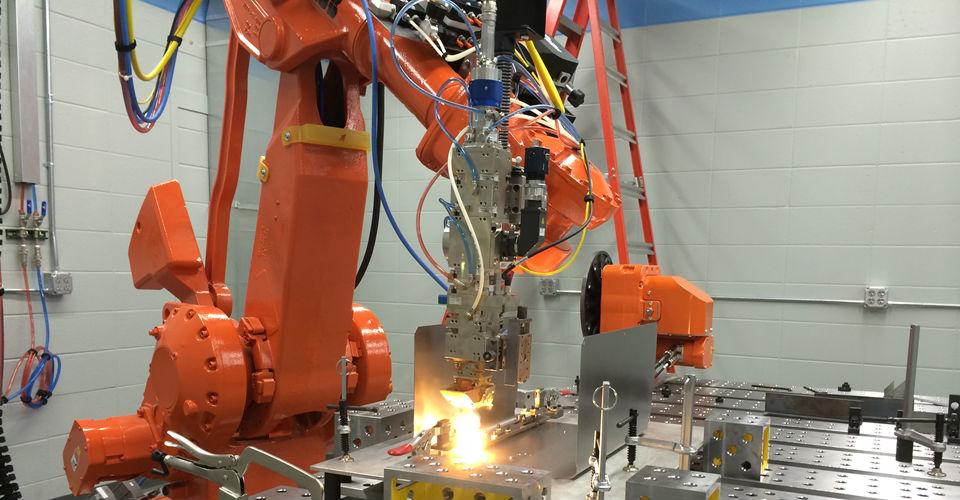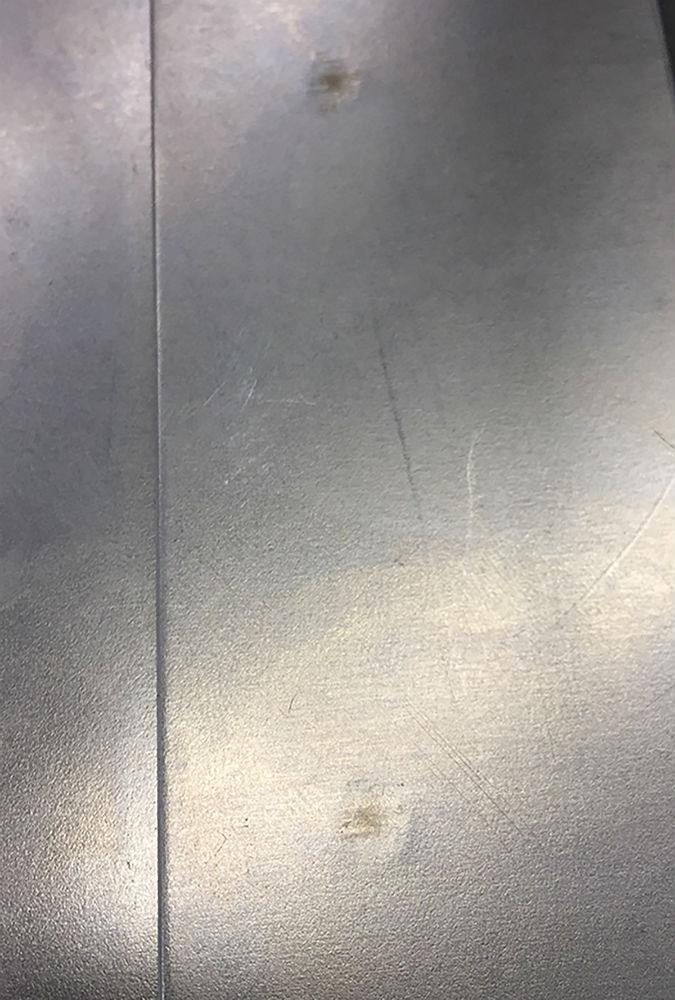Business Development Manager, Laser Group
- FMA
- The Fabricator
- FABTECH
- Canadian Metalworking
Categories
- Additive Manufacturing
- Aluminum Welding
- Arc Welding
- Assembly and Joining
- Automation and Robotics
- Bending and Forming
- Consumables
- Cutting and Weld Prep
- Electric Vehicles
- En Español
- Finishing
- Hydroforming
- Laser Cutting
- Laser Welding
- Machining
- Manufacturing Software
- Materials Handling
- Metals/Materials
- Oxyfuel Cutting
- Plasma Cutting
- Power Tools
- Punching and Other Holemaking
- Roll Forming
- Safety
- Sawing
- Shearing
- Shop Management
- Testing and Measuring
- Tube and Pipe Fabrication
- Tube and Pipe Production
- Waterjet Cutting
Industry Directory
Webcasts
Podcasts
FAB 40
Advertise
Subscribe
Account Login
Search
Converting from laser spot welding to keyhole laser welding
- By Erik Miller and Shuang Liu
- Updated October 26, 2023
- February 21, 2018
- Article
- Laser Welding

Implementing laser keyhole welding can result in a welding process that is three to four times faster compared to resistance spot welding — for improved productivity and efficiency — while also increasing weld quality and repeatability.
Most manufacturers are looking for ways to save money and improve efficiency without negatively impacting quality. Manufacturing operations that are using resistance spot welding can reap significant productivity and quality benefits in some applications by converting to laser keyhole welding.
Implementing laser keyhole welding can result in a welding process that is three to four times faster compared to resistance spot welding, while also increasing weld quality and repeatability. However, laser keyhole welding may not be the right fit for every job.
Keep several factors in mind when considering if laser keyhole welding is the best choice for your welding application.
The Basics of Laser Spot Welding
Resistance spot welding can be used when there is a need to weld together two pieces of material up to 3 mm thick that are stacked on top of each other. This process often is used in the transportation and sheet metal forming industries for applications such as fabricating vehicle body parts and frames, as well as for welding office furniture and toolboxes.
The spot welding process uses two electrodes, one positioned at the bottom of the base material and one at the top. Pressure is applied between the two electrodes, which pushes the two pieces of metal together. A current passes between the electrodes, produces a weld, and fuses the two surfaces together.
One challenge with spot welding is that when the two electrodes release, they leave an indentation on the base metal. In welding applications where aesthetic requirements are important, ridding the material of this indentation requires postweld grinding and often painting, which add time and cost to the process.
Spot welding typically is a manual process; it is difficult and expensive to automate, especially in low- to medium-volume applications. It also is challenging to establish a predictable process when using automated spot welding because the electrodes wear quickly, which means the process parameters and fit-up continually change. This also can affect the repeatability of part quality in spot welding. In addition, the robot necessary to complete automated spot welding is quite heavy and can be cumbersome, which is a drawback to implementation for many operations.
As a rule of thumb, very high part volume is necessary to efficiently automate spot welding. An example of this is automotive part manufacturing, which uses spot welding frequently. Spot welding excels in applications where part fit-up isn’t good and something is needed to press the two pieces together for welding. Spot welding also has a lower-cost point of entry; it requires purchasing a manual single-station spot welder only.
The Basics of Laser Keyhole Welding
In some sheet metal applications that require resistance spot welding, an automated laser keyhole welding process can save time and improve weld quality. The process is well-suited for welding some dissimilar metals, which can be difficult to weld properly with resistance spot welding because of differences in the physical, chemical, and mechanical properties of the base metals.
Laser keyhole welding uses a powerful laser beam to weld two workpieces together. A high-energy-density laser hits a small pinpointed spot on the material. When light hits the top surface, it melts and vaporizes the metal. The pressure of the metal vapor pushes the liquid metal downward and aside, generating a keyhole. As the laser beam is moved across the surface, the keyhole follows the beam and creates a weld that is typically deep and narrow.

One consideration with spot welding is that it leaves an indentation on the base metal. In welding applications where aesthetic requirements are important, ridding the material of this indentation requires postweld grinding and often painting — adding time and cost to the process.
In suitable applications, laser keyhole welding offers:
- Precise control of penetration depth, which eliminates any deformation or indentation on the back side of the bottom part. This reduces the time and money spent on postweld grinding or touchups.
- A very small beam size — less than 1 mm — that results in a small heat-affected zone. This offers benefits when welding thin materials or metals in which controlling heat input is important.
- An extremely fast process that is typically three to four times faster than manual resistance spot welding.
- Consistency and predictability, which result in high-quality finished welds and reduced time and money spent on rework.
Converting from Laser Spot Welding to Keyhole Laser Welding
Converting from resistance spot welding to laser keyhole welding requires considering several key factors to determine if it’s the right choice for the operation and application.
- Cost: Because laser welding is an automated process, it requires an investment in a robotic welding system. For smaller operations that don’t produce a lot of highly repeatable parts, this type of investment may not be feasible or deliver the necessary return on investment (ROI) to justify the purchase.
- Tolerance window for material: Proper tooling and fixturing are critical for success in laser welding. The two workpieces to be welded must be pressed together without a gap to create a high-quality laser weld. This makes the right joint and material presentation important, so the operation must be able to support proper setup and part fit-up.
- Repetition:Laser keyhole welding is best-suited to a repetitive process in which many parts are produced, even if this means a high mix of parts with lower volumes of each part. Because of the necessary investment in system setup, applications with high repetition or high part volume typically offer the best ROI in laser welding.
Considering these factors can help you determine if laser keyhole welding is right for your operation.
About the Authors
Erik Miller
1635 W. Spencer St.
Appleton, WI 54912
(920)-734-9821
Shuang Liu
Laser Engineer, Laser Group
1635 W. Spencer St.
Appleton, WI 54912
(920)-734-9821
Related Companies
subscribe now

The Fabricator is North America's leading magazine for the metal forming and fabricating industry. The magazine delivers the news, technical articles, and case histories that enable fabricators to do their jobs more efficiently. The Fabricator has served the industry since 1970.
start your free subscription- Stay connected from anywhere

Easily access valuable industry resources now with full access to the digital edition of The Fabricator.

Easily access valuable industry resources now with full access to the digital edition of The Welder.

Easily access valuable industry resources now with full access to the digital edition of The Tube and Pipe Journal.
- Podcasting
- Podcast:
- The Fabricator Podcast
- Published:
- 04/16/2024
- Running Time:
- 63:29
In this episode of The Fabricator Podcast, Caleb Chamberlain, co-founder and CEO of OSH Cut, discusses his company’s...
- Industry Events
16th Annual Safety Conference
- April 30 - May 1, 2024
- Elgin,
Pipe and Tube Conference
- May 21 - 22, 2024
- Omaha, NE
World-Class Roll Forming Workshop
- June 5 - 6, 2024
- Louisville, KY
Advanced Laser Application Workshop
- June 25 - 27, 2024
- Novi, MI
































